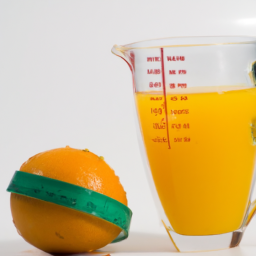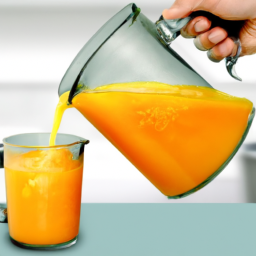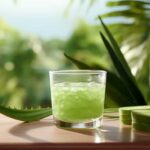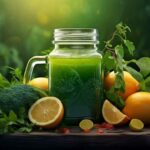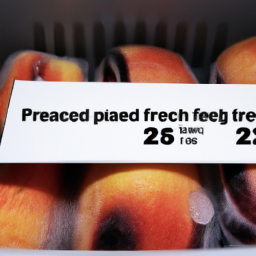Did you know that on average, a medium-sized orange can yield about 1/4 to 1/3 cup of juice? However, the amount of juice obtained from an orange can vary depending on different factors.
As someone who enjoys freshly squeezed orange juice, I’ve always been curious about how much juice I can get from one orange and what affects the yield. In this article, I will delve into the factors that influence orange juice yield and share tips and techniques for maximizing juice extraction.
Orange juice is a popular beverage worldwide, and for good reason. Besides being refreshing and delicious, it is a rich source of vitamin C and other nutrients that are beneficial for our health. However, not all oranges are created equal, and some may produce more juice than others.
By understanding the factors that affect orange juice yield and using the right tools and techniques, you can get the most out of your oranges and enjoy a glass of freshly squeezed orange juice anytime. So, let’s explore the world of orange juice and discover how much juice you can get from one orange!
Key Takeaways
- The amount of juice obtained from one medium orange can range between 1/4 to 1/3 cup, depending on ripeness, juicing technique, and type of juicer used.
- Blood oranges have a higher juice yield due to their higher acid content and thinner membrane, while navel oranges have a thicker membrane resulting in lower juice yield.
- Oranges are a popular source of vitamin C, potassium, and folate, and can be used in cocktails, marinades, dressings, and smoothies.
- While orange juice contains antioxidants and fiber, it also has drawbacks such as high sugar content, acidity, added sugars, and limited fiber, and should be consumed in moderation.
Factors Affecting Orange Juice Yield
The amount of juice you can get from one orange is affected by various factors. For instance, the ripeness of the fruit is a significant determinant of the juice yield. When the fruit is too ripe, it may become soft, which reduces the amount of juice that can be extracted. On the other hand, an unripe fruit may not produce enough juice because it doesn’t contain enough water. Therefore, it’s essential to choose oranges that are ripe but not overly soft or firm to get the best yield.
Another factor that affects the amount of juice you can get from an orange is the juicing method used. Some juice extraction methods are more efficient than others, which can affect the yield. For instance, hand-squeezing an orange may not yield as much juice as using an electric juicer. However, it’s important to note that the type of juicer used also plays a significant role in the yield.
Thus, it’s recommended to use a high-quality juicer that’s designed to extract every last drop of juice from the fruit. With these factors in mind, let’s explore how much juice you can expect from one orange.
How Much Juice Can You Expect from One Orange?
I’ve always wondered how much juice I can get from one orange.
It turns out that the average yield for a medium-sized orange is about 1/3 cup or 80ml. However, there can be variations in yield depending on factors such as the variety of orange, its ripeness, and the juicing method used. For example, some juicing methods like using a hand juicer may result in slightly less juice compared to electric juicers, which tend to extract more. Additionally, certain varieties like Valencia oranges are known for higher juice yield from one orange compared to Navel oranges. Ultimately, experimenting with different types and ripeness levels can help you discover which oranges provide the best juice yield from one orange for your needs.
Additionally, when compared to other citrus fruits, oranges tend to have a higher yield than lemons or limes but a lower yield than grapefruits or tangerines.
Average Juice Yield
Usually, an average orange yields about a quarter cup of juice. However, juice extraction can vary depending on the type of orange and juicing techniques used. To give you a better idea of the juice yield for different types of oranges, here is a table showing the average juice yield for three popular varieties:
| Orange Variety | Juice Yield (in cups) |
|---|---|
| Valencia | 1/3 |
| Navel | 1/4 |
| Blood Orange | 1/2 |
As you can see, blood oranges produce more juice compared to other varieties. This is because they have a higher acid content and a thinner membrane, which makes it easier to extract the juice. On the other hand, Navels have a thicker membrane, resulting in a lower juice yield.
Moving on to the next subtopic, while the average juice yield for oranges is about a quarter cup, variations in yield can occur due to several factors.
Variations in Yield
Juice yield can fluctuate depending on factors such as ripeness, juicing technique, and the type of juicer used. When it comes to ripeness, a fully ripe orange yields more juice than an underripe or overripe one. Juicing technique also plays a role, as squeezing the orange by hand may not extract as much juice as using a juicer. Lastly, the type of juicer used can affect the amount of juice extracted.
A centrifugal juicer may extract more juice but with more pulp, while a masticating juicer may extract less juice but with less pulp. Orange varieties can also affect the amount of juice extracted. For example, navel oranges are known to have more juice than Valencia oranges. Additionally, blood oranges have a unique flavor but may yield less juice due to their thicker skin.
Despite these variations in yield, oranges are still a popular choice for juice extraction due to their high vitamin C content and refreshing taste. In comparison to other citrus fruits, oranges may not yield as much juice as a grapefruit or lemon, but their mild sweetness and versatility make them a popular choice for juicing.
Comparison to Other Citrus Fruits
When it comes to citrus fruits, the saying "when life gives you lemons, make lemonade"highlights the popularity of lemons for their tart flavor and high juice yield. However, there are other citrus fruits that are just as versatile when it comes to cooking and juicing.
Oranges, for example, are a great source of vitamin C and have a sweet and tangy flavor that makes them perfect for juicing. Grapefruits, on the other hand, are known for their bitter taste, but they are also a great source of antioxidants.
Citrus juice varieties differ not only in flavor but also in juicing techniques. Oranges and lemons are relatively easy to juice, with many households using a simple hand-held juicer or even just squeezing the fruit by hand. However, extracting juice from grapefruits can be more challenging due to their thick rind and tough membranes. Using an electric juicer or a specialized citrus press can be helpful in maximizing juice yield.
Nonetheless, when it comes to comparing juice yields, it is important to consider not only the fruit variety but also the juicing technique used. Tools and techniques for maximizing juice yield can make a big difference in how much juice you get from one orange or any other citrus fruit.
Tools and Techniques for Maximizing Juice Yield
By using a citrus reamer, you’ll be amazed at the amount of juice you can extract from a single orange! This tool is specifically designed to extract the maximum amount of juice from citrus fruits. Simply cut the orange in half, and press the reamer into the flesh of the fruit, twisting and turning as you go. The juice will flow out of the fruit and into a bowl or container below. Not only does this technique maximize juice yield, but it also ensures that you get every last drop of juice from the fruit.
To further maximize juice yield, you can also try using a juicer or squeezing the orange by hand. However, these methods may not be as effective as using a citrus reamer. Additionally, the pulp that is left over after juicing can be used in a variety of ways, such as adding it to smoothies or using it in baking recipes. By using these juice extraction techniques and finding alternative uses for orange pulp, you’ll be able to get the most out of every orange you purchase.
When it comes to choosing the best oranges for juicing, there are a few tips to keep in mind.
Tips for Choosing the Best Oranges
Now that we know the best tools and techniques for maximizing juice yield, let’s talk about how to choose the best oranges for juicing. It’s important to keep in mind that the quality of the oranges you use will directly affect the amount of juice you can extract.
When selecting oranges, consider their seasonal availability and whether they are organic or conventional. Seasonal oranges tend to be sweeter and juicier than out-of-season ones, so try to purchase oranges during their peak season, which is from December to April. Additionally, organic oranges may have a more intense flavor and higher nutrient content than conventionally grown ones, but they may also be more expensive. Ultimately, it’s up to your personal preference and budget to decide which type of orange to use.
When it comes to storing oranges for maximum juice yield, there are a few things to keep in mind.
Storing Oranges for Maximum Juice Yield
To ensure optimal juice extraction, it’s crucial to properly store your oranges. Here are some juicing techniques and orange storage methods that I use to get the most juice out of my oranges:
-
Store oranges in the refrigerator: Keeping oranges in the fridge not only increases their shelf life, but also helps to retain their moisture content. Cold oranges are easier to juice and yield more juice than those kept at room temperature.
-
Roll oranges before juicing: Rolling oranges on a hard surface like a countertop or cutting board helps to break down the cell walls inside the fruit. This makes it easier to extract the juice and results in a higher yield.
By using these simple tips, I’ve been able to get the most out of my oranges and enjoy their delicious juice.
Now that we’ve discussed how to maximize juice yield, let’s move on to the next step of using leftover orange pulp.
Using Leftover Orange Pulp
After juicing your oranges, don’t throw away the leftover pulp! Instead, try using it in a variety of creative ways to add flavor and texture to your dishes. You can make orange pulp muffins, orange pulp vinaigrette, or even orange pulp ice cream. Incorporating leftover orange pulp into your recipes not only reduces waste, but also adds a unique twist to your meals.
In addition to adding flavor and texture, orange pulp is a great source of fiber. Just one orange contains about 3 grams of fiber, and much of that fiber is found in the pulp. So, by using leftover orange pulp in your recipes, you’re also increasing the nutritional value of your dishes.
Now, let’s move on to the next section and talk about the nutritional benefits of orange juice.
Nutritional Benefits of Orange Juice
If you’re looking for a refreshing and nutritious way to start your day, consider pouring yourself a glass of freshly squeezed orange juice. Not only is it delicious, but it also provides numerous health benefits.
For example, orange juice is an excellent source of vitamin C, which is essential for a healthy immune system. Additionally, it contains potassium, which helps regulate blood pressure, and folate, which is important for proper fetal development.
But the nutritional value of orange juice doesn’t end there. It also contains antioxidants, such as beta-carotene and flavonoids, which can help protect against chronic diseases like heart disease and cancer. Furthermore, orange juice is a good source of fiber, which can aid in digestion and promote feelings of fullness.
So, if you’re looking for a healthy and delicious way to start your day, consider adding fresh orange juice to your breakfast routine.
While orange juice has many health benefits, it’s important to note that there are also potential drawbacks to consuming it. In the next section, we’ll explore some of these potential concerns and discuss how to mitigate them.
Potential Drawbacks of Consuming Orange Juice
Hey, hold up! Before you gulp down that glass of orange goodness, let’s take a look at some of the possible drawbacks of consuming orange juice. While orange juice does provide a wealth of nutrients, there are some health concerns to consider.
-
High sugar content: Orange juice is naturally high in sugar, which can lead to weight gain and increase the risk of developing type 2 diabetes if consumed in excess.
-
Acidic: Orange juice is also highly acidic, which can erode tooth enamel over time and contribute to acid reflux.
-
Added sugars: Many store-bought orange juices have added sugars, which can negate the health benefits of the fruit and lead to further health problems.
-
Limited fiber: Orange juice lacks the fiber found in whole oranges, which can lead to digestive issues and a less satisfying sense of fullness.
Despite these potential drawbacks, orange juice can still be a healthy part of one’s diet when consumed in moderation.
Now, let’s move on to the next section where we’ll explore some creative uses for orange juice.
Creative Uses for Orange Juice
I love orange juice, and I’m always looking for creative ways to use it in my cooking and drinks. One great way to use orange juice is in cocktails, where it adds a bright, tangy flavor to classic drinks like mimosas and screwdrivers.
It’s also great in marinades and dressings, where the acidity helps tenderize meat and adds a zesty kick to salads.
And of course, orange juice is a staple ingredient in smoothies and shakes, where it adds natural sweetness and a burst of vitamin C.
Cocktails
Cocktails are a great way to enjoy the delicious flavor and juice from one orange in a refreshing and boozy way.
There are many orange juice mixing recipes out there, but some of the best cocktails with orange juice include the classic Screwdriver, the Margarita, and the Tequila Sunrise.
The Screwdriver is a simple yet satisfying drink made with vodka and orange juice, while the Margarita adds a bit of lime and tequila to the mix.
The Tequila Sunrise is a beautiful and fruity drink made with tequila, orange juice, and grenadine, creating a sunrise effect in the glass.
Not only do these cocktails taste great, but they are also easy to make at home with just a few ingredients.
Simply mix together the desired amounts of orange juice, alcohol, and any additional ingredients, and serve over ice.
These cocktails are perfect for a summer day or a night in with friends.
Now, let’s move on to the next section about marinades and dressings.
Marinades and Dressings
Marinades and dressings can add a burst of flavor to any dish, and using freshly squeezed orange in them can give a tangy sweetness that perfectly complements the savory ingredients. Here are some of my favorite ways to incorporate orange juice into my marinade recipes and dressing variations:
- Whisk together orange juice, soy sauce, honey, and garlic for a delicious Asian-inspired marinade for chicken or beef.
- Mix orange juice, olive oil, and balsamic vinegar for a citrusy salad dressing that’s perfect for summer.
- Combine orange juice, lime juice, and cumin for a zesty marinade for grilled shrimp or fish.
- Add orange juice, Dijon mustard, and honey to a basic vinaigrette for a sweet and tangy dressing that goes well with roasted vegetables.
- Mix orange juice, olive oil, and red wine vinegar for a bold and refreshing marinade for lamb chops or steak.
Using freshly squeezed orange juice in marinades and dressings is a simple and easy way to elevate any dish. But orange juice isn’t just for savory recipes! In the next section, we’ll explore how to incorporate orange juice into smoothies and shakes.
Smoothies and Shakes
Now that we’ve learned about marinades and dressings, let’s talk about something a little sweeter: smoothies and shakes! As someone who loves to start their day with a nutritious and delicious drink, I’m excited to share some of my favorite smoothie recipes and the health benefits they offer.
Smoothies are a great way to pack in a lot of nutrients in one convenient drink. By blending together fruits, vegetables, and other ingredients like yogurt or nut butter, you can create a tasty and satisfying beverage that’s also good for you.
Some popular smoothie ingredients include spinach, kale, bananas, berries, and avocado. Not only do these ingredients provide essential vitamins and minerals, but they can also help boost your immune system, improve digestion, and promote healthy skin.
So why not try blending up a smoothie for breakfast or as a mid-day snack? Your body will thank you!
Frequently Asked Questions
Are all varieties of oranges the same in terms of juice yield?
Comparing orange varieties, juice yield differences can be significant. Like different breeds of dogs, each has unique characteristics. Valencia oranges, for example, tend to yield more juice than navel oranges.
Can you substitute bottled orange juice for fresh orange juice in recipes?
I’ve found that you can substitute bottled orange juice for fresh in recipes, but it may affect the taste and texture. To maintain the best flavor, use fresh juice and consider adjusting other recipe components to accommodate the difference in liquid. Some recipe tips include using a citrus press to increase juice yield and selecting oranges that are heavy for their size.
How does the age of the orange affect the amount of juice it yields?
The age of an orange can affect its juice yield variability due to factors affecting juice extraction such as the amount of pulp and moisture content. This variability may impact the amount of juice obtained from an orange.
What is the best way to clean juicing tools after use?
Cleaning juicing tools after use is important to prevent bacterial growth. Effective disinfectants like vinegar or hydrogen peroxide can be used for eco friendly cleaning. It’s best to clean the tools immediately after use to prevent buildup. As for a rhetorical device, let’s start off with a pun: "Juice gotta be kidding me if you’re not disinfecting your juicing tools!"
Is it better to juice oranges with or without the peel?
When juicing oranges, it’s better to remove the peel to avoid bitterness. However, the peel contains nutrients and fiber that can benefit the body. Juicing may decrease some nutritional value, but still provides vitamins and hydration.
Conclusion
Well folks, after all that research and experimentation, it turns out that you can only get so much juice from one orange! Despite our best efforts to maximize yield with fancy tools and techniques, the reality is that oranges have a finite amount of juice inside them. Who knew?
But fear not, my fellow orange enthusiasts. Just because we can’t squeeze every last drop out of each fruit doesn’t mean we can’t enjoy the delicious, nutritious juice that we do get. And let’s not forget about the creative uses for orange juice – whether you’re making a marinade, a cocktail, or just adding a splash to your morning smoothie, there are endless possibilities.
So while we may not be able to magically conjure up gallons of juice from a single orange, let’s appreciate what we can get and savor every sip. And who knows, maybe one day we’ll discover a way to extract even more juice from our beloved citrus fruits.
Until then, let’s raise a glass (of orange juice, of course) to the simple pleasures in life. Cheers!
Cindy thoroughly researches juicing trends, techniques, and recipes to provide readers with practical advice and inspiration. Her writing style is accessible, engaging, and designed to make complex concepts easy to understand. Cindy’s dedication to promoting the advantages of juicing shines through her work, empowering readers to make positive changes in their lives through the simple act of juicing.

